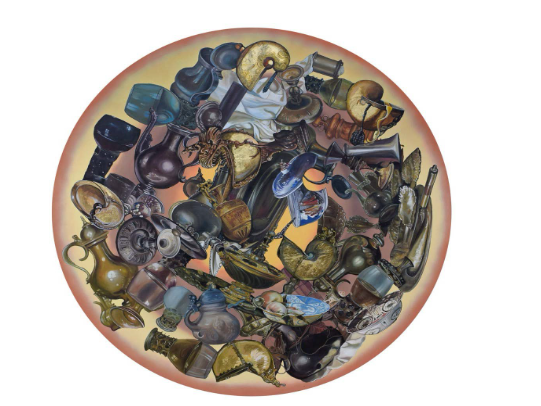
History and Gluttony
This is artist Melissa Furness, and this area of the exhibition surrounds the conceptual theme of art history and gluttony. These works to depict compilations of objects commonly used within the history of painting as a critique of the western cannon of art and the gluttony that is formed what we know of capitalism today.
So these pieces reflect my own deep connection to Italy, which, you know, is the place where I first studied abroad myself. This was a very striking experience for me and really transformed, you know, who I've become as an artist. And so I now, you know, find it really important to take my own university students there every other year to be inspired in the same way that I was.
So I decided to use the idea of the pile of stuff in order to take something that is seen as important or revered in a way, like certain motifs or imagery in history of art, and gather them together and put them in a pile in order to change or remove their historically established meaning. So I feel that the discarded trash of a culture even reveals just as much, if not more than the beautiful paintings of its past.
And so with these pieces, and this part of the exhibition, I have taken elements that were repeated visual symbols and objects in the paintings of their day and extracted them from their original sources. So these collections of items were repeated motifs representing ideals of opulence, beauty and knowledge.
So the sources were often so-called Masters works of their time, part of what was established as the best of the best in the canon of Western art. So an art at the Canon is a timeline of artist and there artworks that are considered to be, supposedly great or old Masters. It's a curated hierarchy of artists that are studied, copied and revered, and is often viewed as static.
So the Canon also reveals historical biases such as favoring art created by those who have held the most power in society. So I'm sure you recognize that, you know, these works are paintings within paintings. You notice that I have extracted certain elements from these historic paintings and put them in my work and the elements that I have extracted represent, like I mentioned, this opulence and beauty in their time, and also showed the mastery of the artist and the ideals of the human form and certain important symbolic subjects. Sso I took these items from their original sources and recontextualize them as a context as a collected pile like rubbish to be visually discarded as cliche rather than to individually revere.
So the titles of these works also refer to this as I use common idioms to title the pieces and further represent the commonplace. So you can see in the video here, a slideshow of all the historical works of the pieces that I depicted in these paintings that are interspersed with idioms associated with the objects depicted. So I was interesting to try and paint like all these different artists. Definitely not easy. So I also became engrossed in certain comical aspects that made it clear that these paintings are essentially collages. You'll notice that like a head, there's no connecting body to it, or there might be like a severed hand or an odd bunny within a piece. So look for some of these fun details, I kind of enjoyed playing around with that.
Additionally I place these piles of stuff in an isolated airbrush background in the manner of pop art, which would further emphasize the flattening of their importance. So in producing these works as ruinous rubbish, I seek to question this history and how it has affected what has become of our society today.